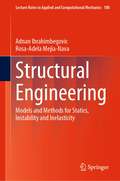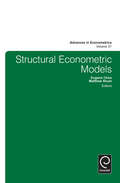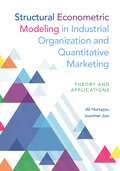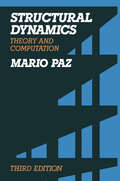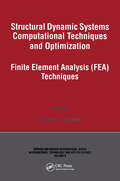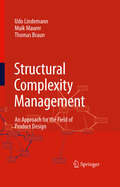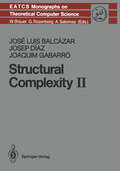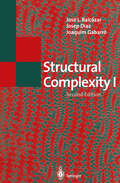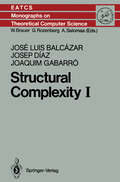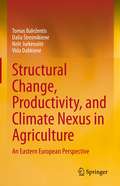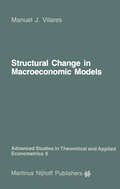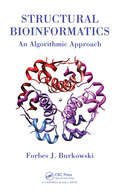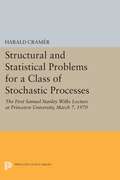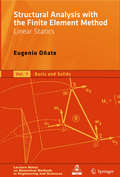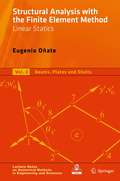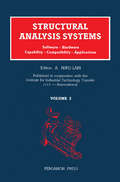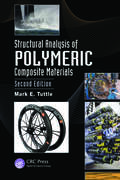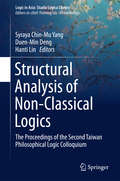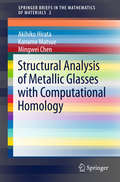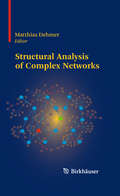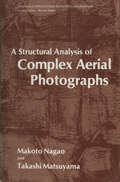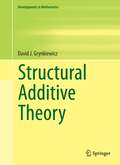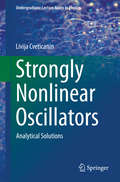- Table View
- List View
Structural Engineering: Models and Methods for Statics, Instability and Inelasticity (Lecture Notes in Applied and Computational Mechanics #100)
by Adnan Ibrahimbegovic Rosa-Adela Mejia-NavaThis book presents a novel approach to the classical scientific discipline of Structural Engineering, which is inspired by numerous current applications from domains of Civil, Mechanical or Aerospace Engineering. The main goal of this book is to help with making the best choice between accuracy and efficiency, when it comes to building the most suitable structural models by practising engineers using modern computational tools available in commercial software products (SAP, FEAP, ANSYS …) for which we have carried out many developments that have been become the main reference in the field. Any development of this kind is not a mere modification of discrete approximation, but a thorough treatment with a sound theoretical formulation based upon Hu-Washizu variational principle with independent rotation field, its corresponding regularization and finally the most appropriate finite element interpolation that can match those used for structural elements. Proposed approach allows us to provide a unified discrete approximation of complex structural assemblies and greatly simplify the modeling task for structural engineers. Thus, in conclusion, this book can also be perceived as the theoretical manual for using modern computer models successfully by practising engineers.
Structural Econometric Models (Advances in Econometrics #31)
by Eugene Choo Matthew ShumThis volume of Advances in Econometrics focuses on recent developments in the use of structural econometric models in empirical economics. The papers in this volume are divided in to three broad groups. The first part looks at recent developments in the estimation of dynamic discrete choice models. This includes using new estimation methods for these models based on Euler equations, estimation using sieve approximation of high dimensional state space, the identification of Markov dynamic games with persistent unobserved state variables and developing test of monotone comparative static in models of multiple equilibria. The second part looks at recent advances in the area empirical matching models. The papers in this section look at developing estimators for matching models based on stability conditions, estimating matching surplus functions using generalized entropy functions, solving for the fixed point in the Choo-Siow matching model using a contraction mapping formulation. While the issue of incomplete, or partial identification of model parameters is touched upon in some of the foregoing chapters, two chapters focus on this issue, in the context of testing for monotone comparative statics in models with multiple equilibria, and estimation of supermodular games under the restrictions that players' strategies be rationalizable. The last group of three papers looks at empirical applications using structural econometric models. Two applications applies matching models to solve endogenous matching to the loan spread equation and to endogenize marriage in the collective model of intrahousehold allocation. Another applications looks at market power of condominium developers in the Japanese housing market in the 1990s.
Structural Econometric Modeling in Industrial Organization and Quantitative Marketing: Theory and Applications
by Ali Hortaçsu Joonhwi JooA concise and rigorous introduction to widely used approaches in structural econometric modeling Structural econometric modeling specifies the structure of an economic model and estimates the model’s parameters from real-world data. Structural econometric modeling enables better economic theory–based predictions and policy counterfactuals. This book offers a primer on recent developments in these modeling techniques, which are used widely in empirical industrial organization, quantitative marketing, and related fields. It covers such topics as discrete choice modeling, demand modes, estimation of the firm entry models with strategic interactions, consumer search, and theory/empirics of auctions. The book makes highly technical material accessible to graduate students, describing key insights succinctly but without sacrificing rigor.• Concise overview of the most widely used structural econometric models• Rigorous and systematic treatment of the topics, emphasizing key insights• Coverage of demand estimation, estimation of static and dynamic game theoretic models, consumer search, and auctions• Focus on econometric models while providing concise reviews of relevant theoretical models
Structural Dynamics: Theory and Computation
by Mario Pazsolution, are provided for calculation of the responses to forces or motions exciting the structure. The new chapters in earthquake-resistant design of buildings describe the provisions of both the 1985 and 1988 versions of the UBC (Uniform Building Code) for the static lateral force method and for the dynamic lateral force method. Other revisions of the book include the presentation of the New mark beta method to obtain the time history response of dynamic systems, and the direct integration method in which the response is found assuming that the excitation function is linear for a specified time interval. A modifi cation of the dynamic condensation method, which has been developed re cently by the author for the reduction of eigenproblems, is presented in Chap ter 13. The proposed modification substantially reduces the numerical operation required in the implementation of the dynamic condensation method. The subjects in this new edition are organized in six parts. Part I deals with structures modeled as single degree-of-freedom systems. It introduces basic concepts and presents important methods for the solution of such dynamic systems. Part II introduces important concepts and methodology for multi degree-of-freedom systems through the use of structures modeled as shear buildings. Part III describes methods for the dynamic analysis of framed struc tures modeled as discrete systems with many degrees of freedom.
Structural Dynamics
by Einar N. StrømmenThe first part of this book covers the general theory of structural dynamics, in a calculous format as well as a finite element formulation. Secondly, it contains methods of eigenvalue calculations of civil engineering structural systems. And third, it contains a major part covering dynamic displacement response calculations as induced by earthquake, turbulent wind, vortex shedding and moving vehicles, enabling the designer to evaluate structural safety from the effects of fluctuating internal forces.The general theory contains comprehensive development of the principle of virtual displacements, as well as the Galerkin solution to eigenvalue problems. A separate chapter has been dedicated to the suspension bridge. The theory of single or multiple tuned mass dampers is included, a theory not presented elsewhere.The book contains a chapter covering the theory of structural damping, as well as comprehensive data of the structural damping properties that are necessary forany dynamic response calculation. The book is intended for students as well as practising engineers. It contains numerous relevant examples, covering numerical solutions that are well suited for computer programming.
Structural Dynamic Systems Computational Techniques and Optimization: Finite Element Analysis Techniques (Gordon And Breach International Series In Engineering, Technolo Ser.)
by Cornelius T. LeondesThe finite element, an approximation method for solving differential equations of mathematical physics, is a highly effective technique in the analysis and design, or synthesis, of structural dynamic systems. Starting from the system differential equations and its boundary conditions, what is referred to as a weak form of the problem (elaborated in the text) is developed in a variational sense. This variational statement is used to define elemental properties that may be written as matrices and vectors as well as to identify primary and secondary boundaries and all possible boundary conditions. Specific equilibrium problems are also solved. This book clearly reveals the effectiveness and great significance of the finite element method available and the essential role it will play in the future as further development occurs.
Structural Dynamic Systems Computational Techniques and Optimization: Finite Element Analysis Techniques (Gordon And Breach International Series In Engineering, Technolo Ser.)
by Cornelius T. LeondesThe finite element, an approximation method for solving differential equations of mathematical physics, is a highly effective technique in the analysis and design, or synthesis, of structural dynamic systems. Starting from the system differential equations and its boundary conditions, what is referred to as a weak form of the problem (elaborated in the text) is developed in a variational sense. This variational statement is used to define elemental properties that may be written as matrices and vectors as well as to identify primary and secondary boundaries and all possible boundary conditions. Specific equilibrium problems are also solved. This book clearly reveals the effectiveness and great significance of the finite element method available and the essential role it will play in the future as further development occurs.
Structural Complexity Management: An Approach for the Field of Product Design
by Udo Lindemann Maik Maurer Thomas BraunProduct design is characterized by a steady increase in complexity. The main focus of this book is a structural approach on complexity management. This means, system structures are considered in order to address the challenge of complexity in all aspects of product design. Structures arise from the complex dependencies of system elements. Thus, the identification of system structures provides access to the understanding of system behavior in practical applications. The book presents a methodology that enables the analysis, control and optimization of complex structures, and the applicability of domain-spanning problems. The methodology allows significant improvements on handling system complexity by creating improved system understanding on the one hand and optimizing product design that is robust for system adaptations on the other hand. Developers can thereby enhance project coordination and improve communication between team members and as a result shorten development time. The practical application of the methodology is described by means of two detailed examples.
Structural Complexity II (Monographs in Theoretical Computer Science. An EATCS Series #22)
by Jose L. Balcazar Josep Diaz Joaquim GabarroThis is the second volume of a two volume collection on Structural Complexity. This volume assumes as a prerequisite knowledge about the topics treated in Volume I, but the present volume itself is nearly self-contained. As in Volume I, each chapter of this book ends with a section entitled "Bibliographical Remarks", in which the relevant references for the chapter are briefly commented upon. These sections might also be of interest to those wanting an overview of the evolution of the field, as well as relevant related results which are not included in the text. Each chapter includes a section of exercises. The reader is encouraged to spend some time on them. Some results presented as exercises are occasionally used later in the text. A reference is provided for the most interesting and for the most useful exercises. Some exercises are marked with a • to indicate that, to the best knowledge of the authors, the solution has a certain degree of difficulty. Many topics from the field of Structural Complexity are not treated in depth, or not treated at all. The authors bear all responsibility for the choice of topics, which has been made based on the interest of the authors on each topic. Many friends and colleagues have made suggestions or corrections. In partic ular we would like to express our gratitude to Richard Beigel, Ron Book, Rafael Casas, Jozef Gruska, Uwe Schoning, Pekka Orponen, and Osamu Watanabe.
Structural Complexity I (Texts in Theoretical Computer Science. An EATCS Series)
by Jose L. Balcazar Josep Diaz Joaquim GabarroIn the six years since the first edition of this book was published, the field of Structural Complexity has grown quite a bit. However, we are keeping this volume at the same basic level that it had in the first edition, and the only new result incorporated as an appendix is the closure under complementation of nondeterministic space classes, which in the previous edition was posed as an open problem. This result was already included in our Volume II, but we feel that due to the basic nature of the result, it belongs to this volume. There are of course other important results obtained during these last six years. However, as they belong to new areas opened in the field they are outside the scope of this fundamental volume. Other changes in this second edition are the update of some Bibliograph ical Remarks and references, correction of many mistakes and typos, and a renumbering of the definitions and results. Experience has shown us that this new numbering is a lot more friendly, and several readers have confirmed this opinion. For the sake of the reader of Volume II, where all references to Volume I follow the old numbering, we have included here a table indicating the new number corresponding to each of the old ones.
Structural Complexity I (Monographs in Theoretical Computer Science. An EATCS Series #11)
by Jose L. Balcazar Josep Diaz Joaquim GabarroSince the achievement of a fonnal definition of the concept of "algorithm", the Mathematical Theory of Computation has developed into a broad and rich discipline. The notion of "complexity of an algorithm" yields an important area of research, known as Complexity Theory, that can be approached from several points of view. Some of these are briefly discussed in the Introduction and, in particular, our view of the "Structural" approach is outlined there. We feel the subject is mature enough to permit collecting and interrelating many of the results in book fonn. Let us point out that a substantial part of the knowledge in Structural Complexity Theory can be found only in specialized journals, symposia proceedings, and monographs like doctoral dissertations or similar texts, mostly unpublished. We believe that a task to be done soon is a systematization of the interconnections between all the research lines; this is a serious and long task. We hope that the two volumes of this book can serve as a starting point for this systematization process.
Structural Change, Productivity, and Climate Nexus in Agriculture: An Eastern European Perspective
by Tomas Baležentis Dalia Štreimikienė Nelė Jurkėnaitė Vida DabkienėThis monograph addresses the methodological and empirical issues relevant for the development of sustainable agriculture, with a particular focus on Eastern Europe. It relates economic growth to the other dimensions of sustainability by applying integrated methods. The book comprises five chapters dedicated to the theoretical approaches towards sustainable rural development, productivity analysis, structural change analysis and environmental footprint. The book focuses on the transformations of the agricultural sector while taking into account economic, environmental, and social dynamics. The importance of agricultural transformations to the livelihood of the rural population and food security are highlighted. Further, advanced methodologies and frameworks are presented to fathom the underlying trends in different facets of agricultural production. The authors present statistical methods used for the analysis of agricultural sustainability along with applications for agriculture in the European Union. Additionally, they discuss the measures of efficiency, methodological approaches and empirical models. Finally, the book applies econometric and optimization techniques, which are useful for the estimation of the production functions and other representations of technology in the case of the European Union member states. Therefore, the book is a must-read for researchers and students of agricultural and production economics, as well as policy-makers and academia in general.
Structural Change in Macroeconomic Models: Theory and Estimation (Advanced Studies in Theoretical and Applied Econometrics #6)
by M.J. VilaresStructural Bioinformatics: An Algorithmic Approach (Chapman And Hall/crc Mathematical And Computational Biology Ser.)
by Forbes J. BurkowskiThe Beauty of Protein Structures and the Mathematics behind Structural BioinformaticsProviding the framework for a one-semester undergraduate course, Structural Bioinformatics: An Algorithmic Approach shows how to apply key algorithms to solve problems related to macromolecular structure.Helps Students Go Further in Their Study of Structural Biolog
Structural and Statistical Problems for a Class of Stochastic Processes: The First Samuel Stanley Wilks Lecture at Princeton University, March 7, 1970
by Harald CramérProfessor Cramer, author of the pivotal Mathematical Methods of Statistics (1946), examines problems in the theory of stochastic processes that can be considered as generalizations of problems in the classical theory of statistical inference. He discusses first the representation formula and then treats its application to the multiplicity problem, classes of processes with multiplicity N= 1, normal or Gaussian processes. He concludes with a discussion of problems of estimation for a normal process. A distinguished mathematician, Harald Cramer has been President of the University of Stockholm and Chancellor of the Swedish Universities. He is a member of many professional societies, including the Royal Swedish Academy of Science and the American Academy of Arts and Sciences.Originally published in 1971.The Princeton Legacy Library uses the latest print-on-demand technology to again make available previously out-of-print books from the distinguished backlist of Princeton University Press. These editions preserve the original texts of these important books while presenting them in durable paperback and hardcover editions. The goal of the Princeton Legacy Library is to vastly increase access to the rich scholarly heritage found in the thousands of books published by Princeton University Press since its founding in 1905.
Structural Analysis with the Finite Element Method. Linear Statics: Volume 1: Basis and Solids (Lecture Notes on Numerical Methods in Engineering and Sciences)
by Eugenio OñateSTRUCTURAL ANALYSIS WITH THE FINITE ELEMENT METHOD Linear Statics Volume 1 : The Basis and Solids Eugenio Oñate The two volumes of this book cover most of the theoretical and computational aspects of the linear static analysis of structures with the Finite Element Method (FEM). The content of the book is based on the lecture notes of a basic course on Structural Analysis with the FEM taught by the author at the Technical University of Catalonia (UPC) in Barcelona, Spain for the last 30 years. Volume1 presents the basis of the FEM for structural analysis and a detailed description of the finite element formulation for axially loaded bars, plane elasticity problems, axisymmetric solids and general three dimensional solids. Each chapter describes the background theory for each structural model considered, details of the finite element formulation and guidelines for the application to structural engineering problems. The book includes a chapter on miscellaneous topics such as treatment of inclined supports, elastic foundations, stress smoothing, error estimation and adaptive mesh refinement techniques, among others. The text concludes with a chapter on the mesh generation and visualization of FEM results. The book will be useful for students approaching the finite element analysis of structures for the first time, as well as for practising engineers interested in the details of the formulation and performance of the different finite elements for practical structural analysis. STRUCTURAL ANALYSIS WITH THE FINITE ELEMENT METHOD Linear Statics Volume 2: Beams, Plates and Shells Eugenio Oñate The two volumes of this book cover most of the theoretical and computational aspects of the linear static analysis of structures with the Finite Element Method (FEM).The content of the book is based on the lecture notes of a basic course on Structural Analysis with the FEM taught by the author at the Technical University of Catalonia (UPC) in Barcelona, Spain for the last 30 years. Volume 2 presents a detailed description of the finite element formulation for analysis of slender and thick beams, thin and thick plates, folded plate structures, axisymmetric shells, general curved shells, prismatic structures and three dimensional beams. Each chapter describes the background theory for each structural model considered, details of the finite element formulation and guidelines for the application to structural engineering problems Emphasis is put on the treatment of structures with layered composite materials. The book will be useful for students approaching the finite element analysis of beam, plate and shell structures for the first time, as well as for practising engineers interested in the details of the formulation and performance of the different finite elements for practical structural analysis.
Structural Analysis with the Finite Element Method. Linear Statics: Volume 2: Beams, Plates and Shells (Lecture Notes on Numerical Methods in Engineering and Sciences)
by Eugenio OñateSTRUCTURAL ANALYSIS WITH THE FINITE ELEMENT METHOD Linear Statics Volume 1 : The Basis and Solids Eugenio Oñate The two volumes of this book cover most of the theoretical and computational aspects of the linear static analysis of structures with the Finite Element Method (FEM). The content of the book is based on the lecture notes of a basic course on Structural Analysis with the FEM taught by the author at the Technical University of Catalonia (UPC) in Barcelona, Spain for the last 30 years. Volume1 presents the basis of the FEM for structural analysis and a detailed description of the finite element formulation for axially loaded bars, plane elasticity problems, axisymmetric solids and general three dimensional solids. Each chapter describes the background theory for each structural model considered, details of the finite element formulation and guidelines for the application to structural engineering problems. The book includes a chapter on miscellaneous topics such as treatment of inclined supports, elastic foundations, stress smoothing, error estimation and adaptive mesh refinement techniques, among others. The text concludes with a chapter on the mesh generation and visualization of FEM results. The book will be useful for students approaching the finite element analysis of structures for the first time, as well as for practising engineers interested in the details of the formulation and performance of the different finite elements for practical structural analysis. STRUCTURAL ANALYSIS WITH THE FINITE ELEMENT METHOD Linear Statics Volume 2: Beams, Plates and Shells Eugenio Oñate The two volumes of this book cover most of the theoretical and computational aspects of the linear static analysis of structures with the Finite Element Method (FEM).The content of the book is based on the lecture notes of a basic course on Structural Analysis with the FEM taught by the author at the Technical University of Catalonia (UPC) in Barcelona, Spain for the last 30 years. Volume 2 presents a detailed description of the finite element formulation for analysis of slender and thick beams, thin and thick plates, folded plate structures, axisymmetric shells, general curved shells, prismatic structures and three dimensional beams. Each chapter describes the background theory for each structural model considered, details of the finite element formulation and guidelines for the application to structural engineering problems Emphasis is put on the treatment of structures with layered composite materials. The book will be useful for students approaching the finite element analysis of beam, plate and shell structures for the first time, as well as for practising engineers interested in the details of the formulation and performance of the different finite elements for practical structural analysis.
Structural Analysis Systems: Software — Hardware Capability — Compatibility — Applications
by A. Niku-LariStructural Analysis Systems: Software—Hardware Capability—Compatibility—Applications, Volume 2 is a practical guidebook on structural analysis systems and their applications. It provides detailed information about a specific software, its postprocessor capabilities and limitations, computer-aided design connection, and compatibility with the most common computers. Several practical examples from industry with computer and user cost are given. This volume consists of 17 chapters and begins with a description of AFAG, a dual finite element analysis program based on the flexibility method. The discussion then turns to the AQUADYN system, designed primarily to reduce the hydrodynamics problem to a linear integral equation for large floating or immersed structures. The following chapters focus on other structural analysis computer programs such as BOSOR4 and BOSOR5, INFESA, MEF/MOSAIC, RCAFAG, and STRUGEN. Some general purpose and special purpose finite element programs used for stress analysis of composite materials are also considered. This book will be a useful resource for practitioners in scientific and industrial disciplines such as mechanical or civil engineering, informatics, applied mathematics, and computer science.
Structural Analysis of Polymeric Composite Materials
by Mark E. TuttleStructural Analysis of Polymeric Composite Materials, Second Edition introduces the mechanics of composite materials and structures and combines classical lamination theory with macromechanical failure principles for prediction and optimization of composite structural performance. It addresses topics such as high-strength fibers, manufacturing tech
Structural Analysis of Non-Classical Logics: The Proceedings of the Second Taiwan Philosophical Logic Colloquium (Logic in Asia: Studia Logica Library)
by Syraya Chin-Mu Yang Duen-Min Deng Hanti LinThis volume brings together a group of logic-minded philosophers and philosophically oriented logicians to address a diversity of topics on the structural analysis of non-classical logics. It mainly focuses on the construction of different types of models for various non-classical logics of current interest, including modal logics, epistemic logics, dynamic logics, and observational predicate logic. The book presents a wide range of applications of two well-known approaches in current research: (i) structural modeling of certain philosophical issues in the framework of non-classic logics, such as admissible models for modal logic, structural models for modal epistemology and for counterfactuals, and epistemological models for common knowledge and for public announcements; (ii) conceptual analysis of logical properties of, and formal semantics for, non-classical logics, such as sub-formula property, truthmaking, epistemic modality, behavioral strategies, speech acts and assertions. The structural analysis provided in this volume will appeal not only to graduate students and experts in non-classic logics, but also to readers from a wide range of disciplines, including computer science, cognitive science, linguistics, game theory and theory of action, to mention a few.
Structural Analysis of Metallic Glasses with Computational Homology (SpringerBriefs in the Mathematics of Materials #2)
by Akihiko Hirata Kaname Matsue Mingwei ChenThis book introduces the application of computational homology for structural analysis of metallic glasses. Metallic glasses, relatively new materials in the field of metals, are the next-generation structural and functional materials owing to their excellent properties. To understand their properties and to develop novel metallic glass materials, it is necessary to uncover their atomic structures which have no periodicity, unlike crystals. Although many experimental and simulation studies have been performed to reveal the structures, it is extremely difficult to perceive a relationship between structures and properties without an appropriate point of view, or language. The purpose here is to show how a new approach using computational homology gives a useful insight into the interpretation of atomic structures. It is noted that computational homology has rapidly developed and is now widely applied for various data analyses. The book begins with a brief basic survey of metallic glasses and computational homology, then goes on to the detailed procedures and interpretation of computational homology analysis for metallic glasses. Understandable and readable information for both materials scientists and mathematicians is also provided.
Structural Analysis of Complex Networks
by Matthias DehmerFilling a gap in literature, this self-contained book presents theoretical and application-oriented results that allow for a structural exploration of complex networks. The work focuses not only on classical graph-theoretic methods, but also demonstrates the usefulness of structural graph theory as a tool for solving interdisciplinary problems. Applications to biology, chemistry, linguistics, and data analysis are emphasized. The book is suitable for a broad, interdisciplinary readership of researchers, practitioners, and graduate students in discrete mathematics, statistics, computer science, machine learning, artificial intelligence, computational and systems biology, cognitive science, computational linguistics, and mathematical chemistry. It may also be used as a supplementary textbook in graduate-level seminars on structural graph analysis, complex networks, or network-based machine learning methods.
A Structural Analysis of Complex Aerial Photographs (Advanced Applications in Pattern Recognition)
by Makoto Nagao Takashi MatsuyamaIt is most appropriate that the first volume to appear in the series "Advanced Applications in Pattern Recognition" should be this monograph by Nagao and Matsuyama. The work described here is a deep unification and synthesis of the two fundamental approaches to pat tern recognition: numerical (also known as "statistical") and struc tural ("linguistic," "syntactic"). The power and unity of the meth odology flow from the apparently effortless and natural use of the knowledge-base framework illuminated by the best results of artificial intelligence research. An integral part of the work is the algorithmic solution of many hitherto incompletely or clumsily treated problems. It was on the occasion of a laboratory visit in connection with the 4th IJCPR (of ~hich Professor Nagao was the very able Program Chairman) that I saw in operation the system described here. On the spot I expressed the desire to see the work described for the inter national technical audience in this series and the authors were kind enough to agree to contribute to a new and unknown series. With the publication of this monograph on the eve of the 5th ICPR my wish is fu1fi11~d. I want to thank here the authors and Plenum Publishing Corporation for making this volume and the series a reality.
Structural Additive Theory (Developments in Mathematics #30)
by David J. GrynkiewiczNestled between number theory, combinatorics, algebra and analysis lies a rapidly developing subject in mathematics variously known as additive combinatorics, additive number theory, additive group theory, and combinatorial number theory. Its main objects of study are not abelian groups themselves, but rather the additive structure of subsets and subsequences of an abelian group, i.e., sumsets and subsequence sums. This text is a hybrid of a research monograph and an introductory graduate textbook. With few exceptions, all results presented are self-contained, written in great detail, and only reliant upon material covered in an advanced undergraduate curriculum supplemented with some additional Algebra, rendering this book usable as an entry-level text. However, it will perhaps be of even more interest to researchers already in the field. The majority of material is not found in book form and includes many new results as well. Even classical results, when included, are given in greater generality or using new proof variations. The text has a particular focus on results of a more exact and precise nature, results with strong hypotheses and yet stronger conclusions, and on fundamental aspects of the theory. Also included are intricate results often neglected in other texts owing to their complexity. Highlights include an extensive treatment of Freiman Homomorphisms and the Universal Ambient Group of sumsets A+B, an entire chapter devoted to Hamidoune’s Isoperimetric Method, a novel generalization allowing infinite summands in finite sumset questions, weighted zero-sum problems treated in the general context of viewing homomorphisms as weights, and simplified proofs of the Kemperman Structure Theorem and the Partition Theorem for setpartitions.
Strongly Nonlinear Oscillators: Analytical Solutions (Undergraduate Lecture Notes in Physics)
by Livija CveticaninThis book provides the presentation of the motion of pure nonlinear oscillatory systems and various solution procedures which give the approximate solutions of the strong nonlinear oscillator equations. The book presents the original author’s method for the analytical solution procedure of the pure nonlinear oscillator system. After an introduction, the physical explanation of the pure nonlinearity and of the pure nonlinear oscillator is given. The analytical solution for free and forced vibrations of the one-degree-of-freedom strong nonlinear system with constant and time variable parameter is considered. Special attention is given to the one and two mass oscillatory systems with two-degrees-of-freedom. The criteria for the deterministic chaos in ideal and non-ideal pure nonlinear oscillators are derived analytically. The method for suppressing chaos is developed. Important problems are discussed in didactic exercises. The book is self-consistent and suitable as a textbook for students and also for professionals and engineers who apply these techniques to the field of nonlinear oscillations.
